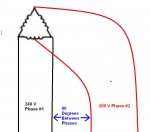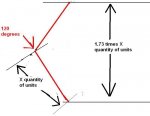K8MHZ
Senior Member
- Occupation
- Electrician
What are we discussing then?
Single phase residential service voltages.
If they were 180 out of phase, Vna would = -Vnb, and the net sum would be zero. (120 + negative 120 = 0)
Since they are in phase, Vna does = Vnb and the net sum is 240. (120 + 120 = 240)
If you looked at all three voltages on a scope, you would only see two waves, as the two 120 volt waves would be superimposed upon each other. If you were looking at a system with a bad neutral, it would be easier to see. If you had 100 volts on one leg and 140 on the other you would then see all three waves and the peaks would all all line up (time wise) on the same side of the zero line at the same time, thus, all being in phase, and thus only a single phase exists.



